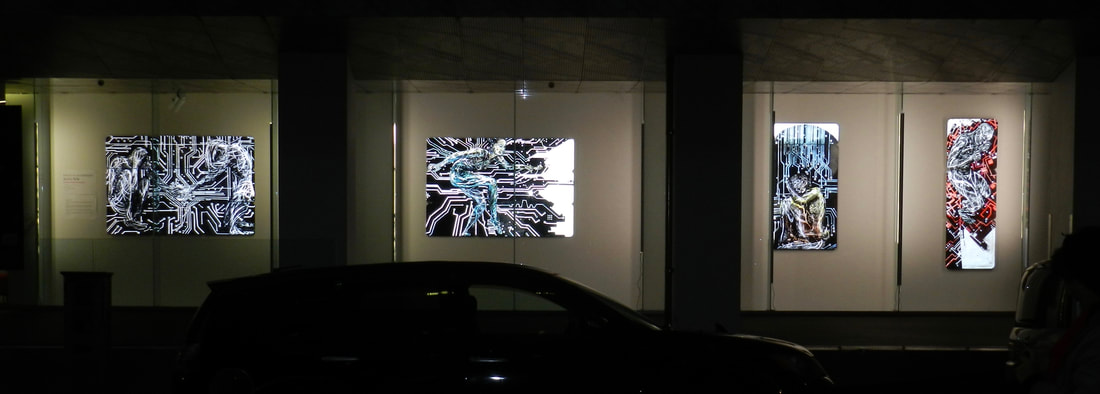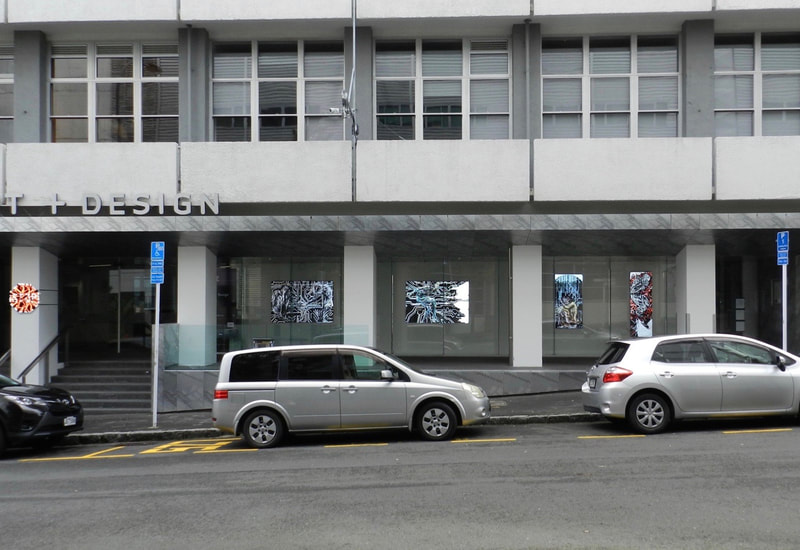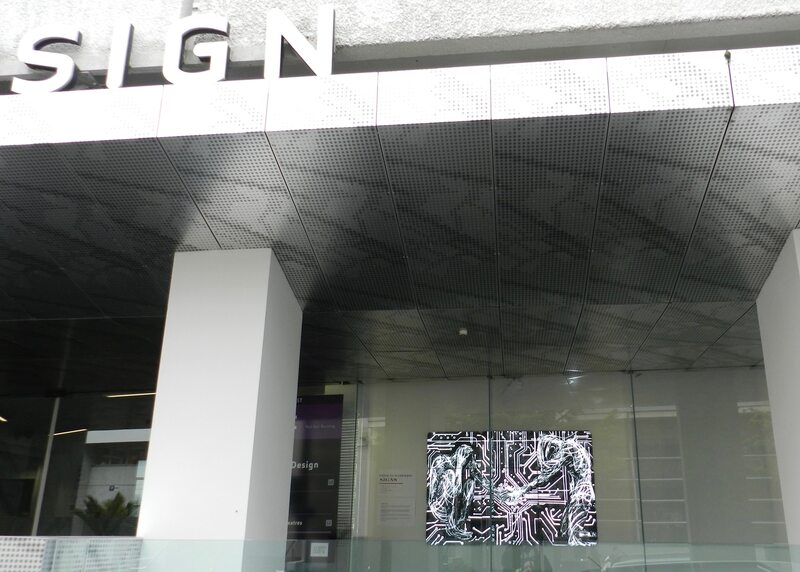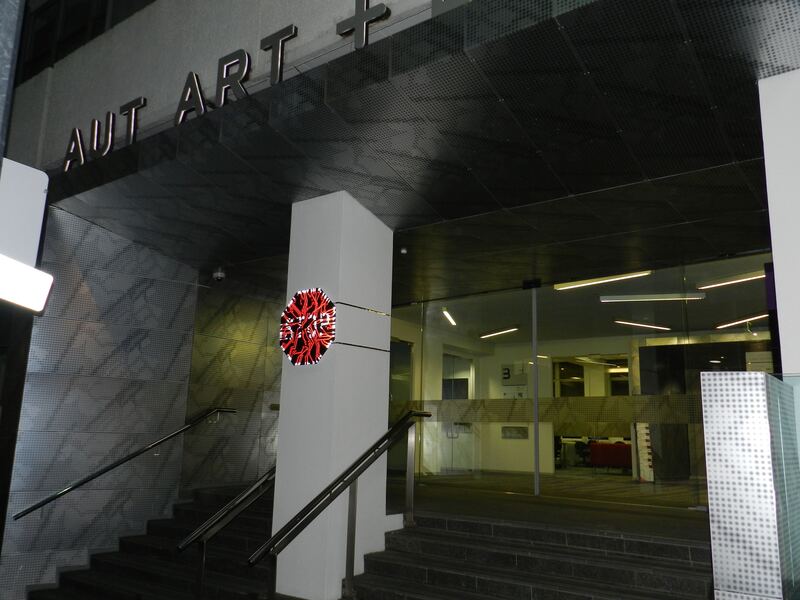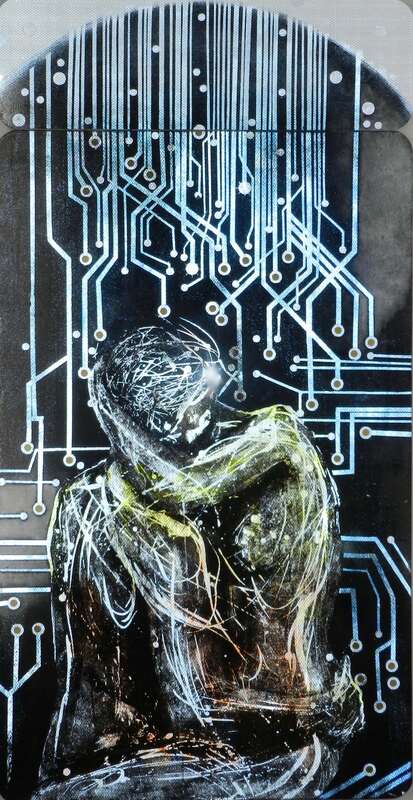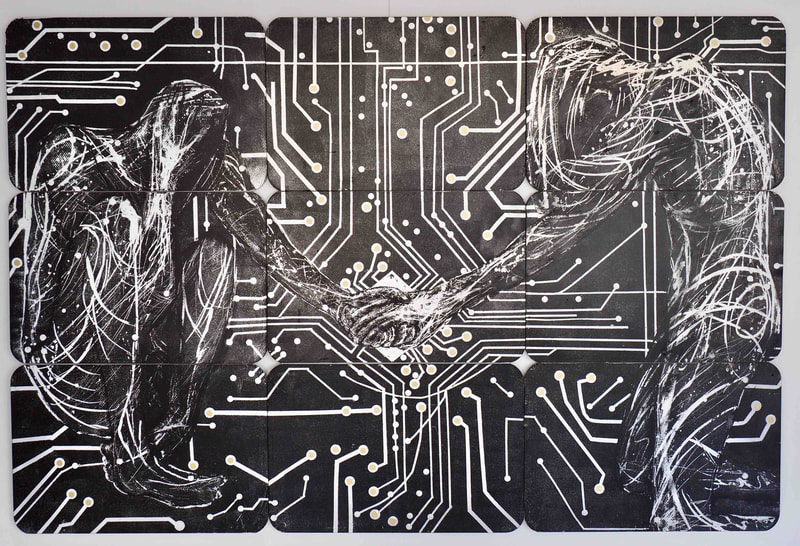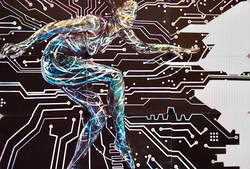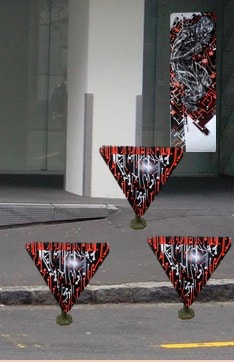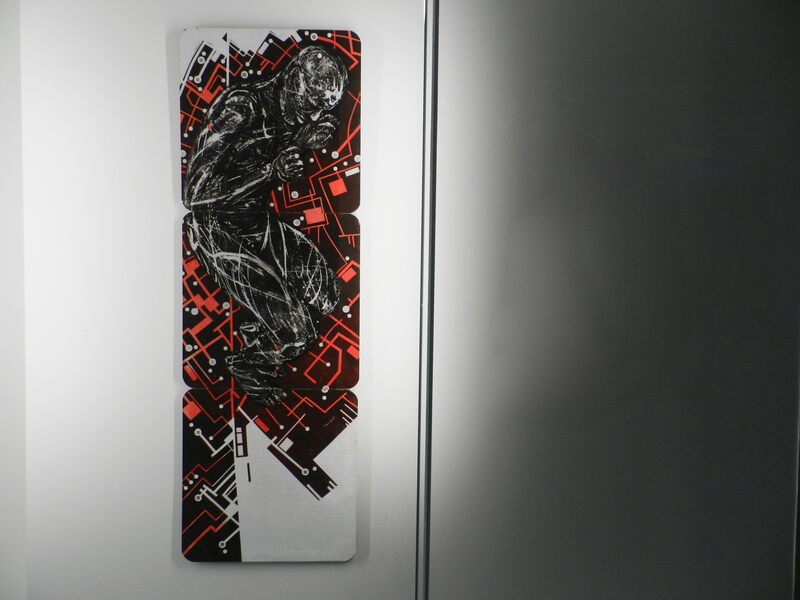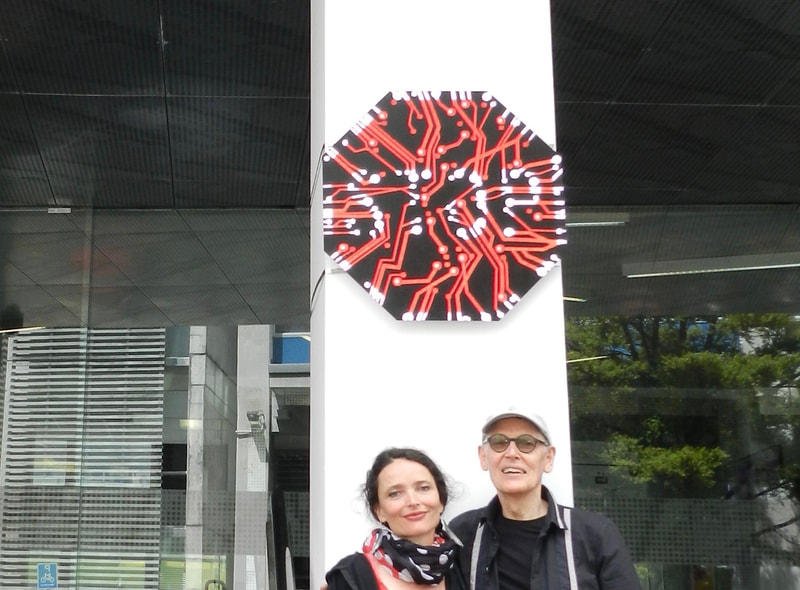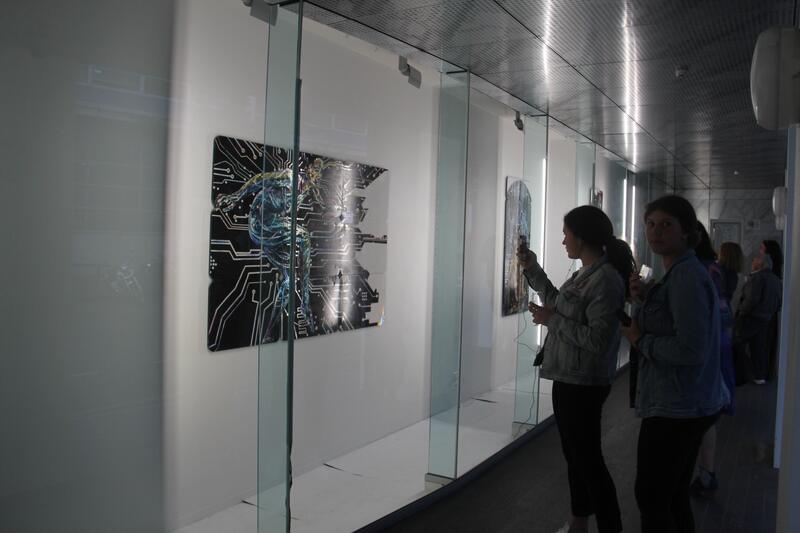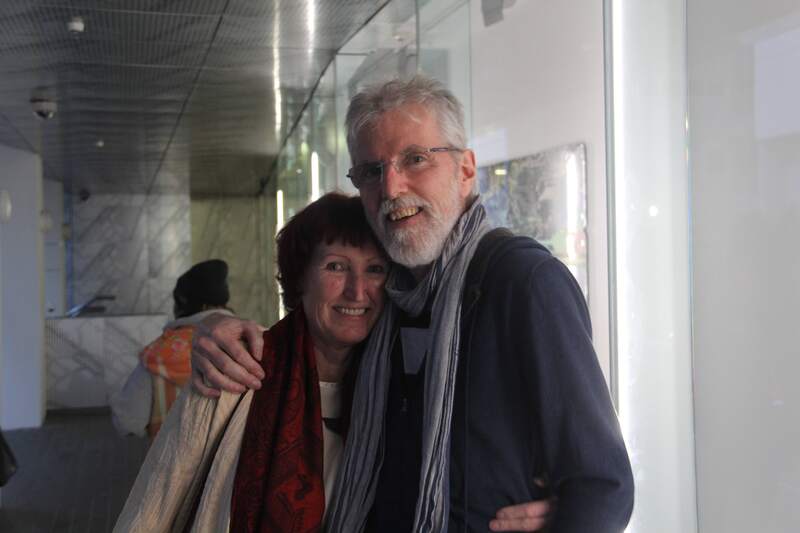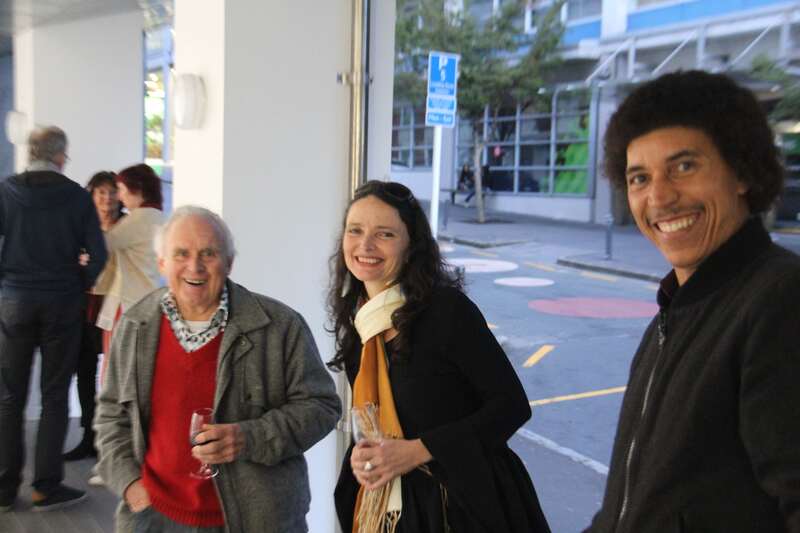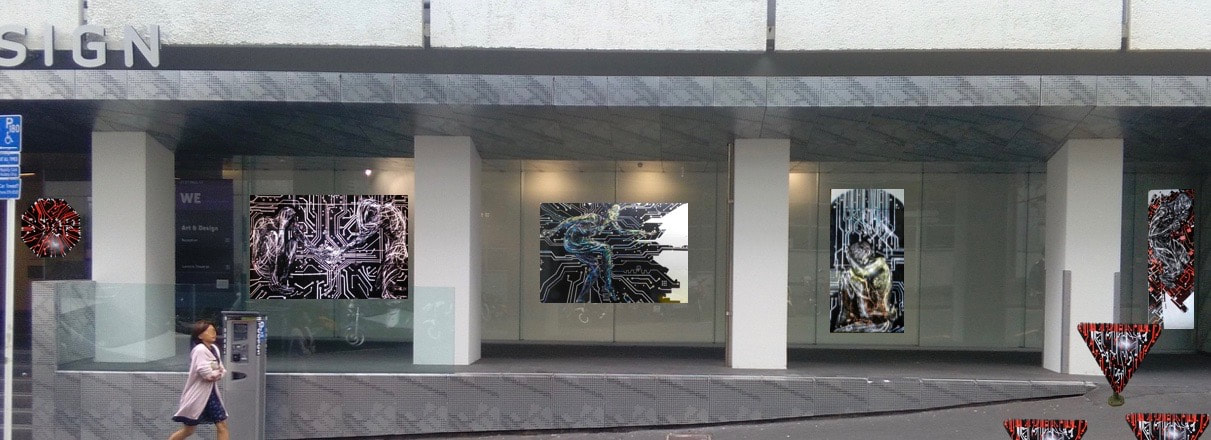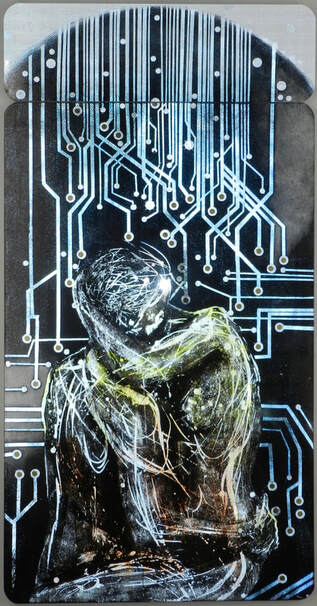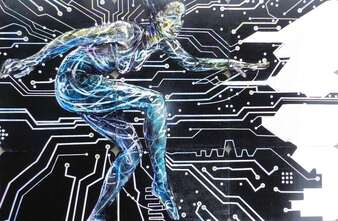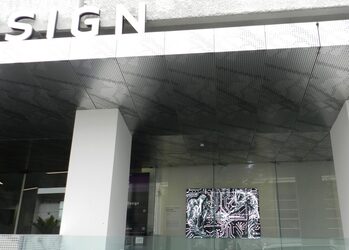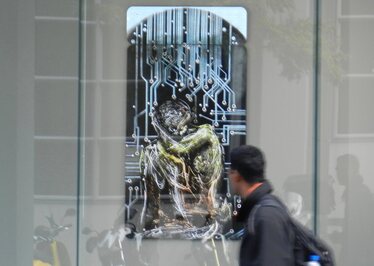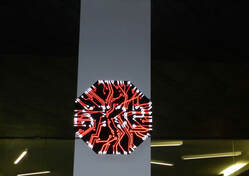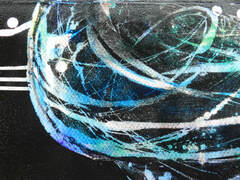About Signs
For 10 years I have been working with used traffic signs as a way to meditate on the impact technology has on shaping and reshaping our bodies, our brains and the planet.
Working with non-digital art-making, I want to invite people to engage in questions around the digital, that are not technological in nature but concerned with relationships.
The works in SIGNS are intended to be experienced as relevant to the viewer in a similar way that a traffic sign is designed to alert the viewer to where one is and where one wants to go.
The material’s reflectivity reacts dramatically to phone-flashes and changes in light as the viewer moves around and interacts with them.
For 10 years I have been working with used traffic signs as a way to meditate on the impact technology has on shaping and reshaping our bodies, our brains and the planet.
Working with non-digital art-making, I want to invite people to engage in questions around the digital, that are not technological in nature but concerned with relationships.
The works in SIGNS are intended to be experienced as relevant to the viewer in a similar way that a traffic sign is designed to alert the viewer to where one is and where one wants to go.
The material’s reflectivity reacts dramatically to phone-flashes and changes in light as the viewer moves around and interacts with them.
Texts by Warren Pringle, James Littlewood and Sue Jowsey
James Littlewood
Finding worlds beyond screens: Delicia Sampero’s Signs exhibit at AUT, October 2019.
St Paul Street in the centre of Auckland is alive with traffic. AUT has progressively colonised this precinct over the last decade, to the point that it’s now of little use to anyone besides those on a pedagogical mission. Here, light hearted architecture opens up the campus buildings to the street in a way that seems to invite interaction at every breath. It’s a space that promotes movement and arrival with equal enthusiasm. Street furniture and cafes blend seamlessly with traffic-mode separators and signage. In these places, filled with people equipping themselves for a better future, navigation is not just about where you’re going; it’s about what you’re doing — the choices you make now, and the ones you hope to make in the times ahead.
Finding worlds beyond screens: Delicia Sampero’s Signs exhibit at AUT, October 2019.
St Paul Street in the centre of Auckland is alive with traffic. AUT has progressively colonised this precinct over the last decade, to the point that it’s now of little use to anyone besides those on a pedagogical mission. Here, light hearted architecture opens up the campus buildings to the street in a way that seems to invite interaction at every breath. It’s a space that promotes movement and arrival with equal enthusiasm. Street furniture and cafes blend seamlessly with traffic-mode separators and signage. In these places, filled with people equipping themselves for a better future, navigation is not just about where you’re going; it’s about what you’re doing — the choices you make now, and the ones you hope to make in the times ahead.
It’s an environment in which Delicia Sampero’s painted installation Signs makes perfect sense. Separated from the footpath by a window, a balcony and a few broad steps, Sampero’s paintings loom over the transient space in a way that’s both energising and reflective. Murkey human body forms — expertly abstracted into fibrous silhouettes — twist and turn amidst a deep and mysterious backdrop of nodes and connectors. The backdrop could be the universe, or a night sky. Or it could be a circuit board, or some hostile matrix. Either way, it dwarfs the human subjects, and these aren’t small paintings.
What you don’t see —- at first — is the substrate. These paintings aren’t on canvas, but rather: repurposed street signs, stitched together into curtain-like hangings.
At first glance, it looks like four works: each in a window space provided by the AUT building housing the university's visual art programme. But — further in keeping with the area’s transient quality — the exhibition has escaped the confines of its own space. A fifth piece Stop is attached to a lamp post. It hangs over your head as you walk into the building: an octagon that was once a stop sign has the backdrop treatment, reminiscent of a test for colour blindness, with the single word “Stop” emerging from the abstract dot pattern.
It can only be a stop sign. Nothing else of that shape and size exists. It even states the word. But just as the word “stop” is broken up, the sign itself is degraded. Like a beacon on a reef, it demarks the outer limit of the exhibition, and in doing so, incites a little riot in the mind of the viewer. Instead of obstructing us, it issues a layered invitation: to approach the exhibition, and to consider this former stop sign’s equivalence with all other signs, repurposed and re-imagined. In life, signs matter, all the time. If a stop sign is no longer a stop sign, what other signs might also relinquish their manifest denotation? Would you notice? Would you care?
The four rectangular paintings within the window space riff further on the idea of losing the self amidst the blazing inferno of signs that surrounds us, and — for the lucky ones — finding the self in the ashes.
What you don’t see —- at first — is the substrate. These paintings aren’t on canvas, but rather: repurposed street signs, stitched together into curtain-like hangings.
At first glance, it looks like four works: each in a window space provided by the AUT building housing the university's visual art programme. But — further in keeping with the area’s transient quality — the exhibition has escaped the confines of its own space. A fifth piece Stop is attached to a lamp post. It hangs over your head as you walk into the building: an octagon that was once a stop sign has the backdrop treatment, reminiscent of a test for colour blindness, with the single word “Stop” emerging from the abstract dot pattern.
It can only be a stop sign. Nothing else of that shape and size exists. It even states the word. But just as the word “stop” is broken up, the sign itself is degraded. Like a beacon on a reef, it demarks the outer limit of the exhibition, and in doing so, incites a little riot in the mind of the viewer. Instead of obstructing us, it issues a layered invitation: to approach the exhibition, and to consider this former stop sign’s equivalence with all other signs, repurposed and re-imagined. In life, signs matter, all the time. If a stop sign is no longer a stop sign, what other signs might also relinquish their manifest denotation? Would you notice? Would you care?
The four rectangular paintings within the window space riff further on the idea of losing the self amidst the blazing inferno of signs that surrounds us, and — for the lucky ones — finding the self in the ashes.
In Compass Rose, a female human treads with dainty caution, navigating the pervasive backdrop with both aspiration and awkwardness. Making the most of her confined space, she is positive, forward looking. Sampero has cunningly orchestrated the layout so that body parts are both contained and released by the grid of rectangles, composed entirely of road-signs. One hand is outstretched, reaching across the grid. The cosmic/techno background seems to reflect and refract across the body, illuminating it and defining it. The outstretched hand almost touches a blank area, where a reduction technique has erased the background, as if she’s reaching for a freedom that lies just out of reach
In Touch(a response to the March 15 mosque attacks) two people hang their heads in despair, while reaching out for each other. Reduced to black and white, the contact point — central within the composition — forms a nexus from which that ever-present backdrop expands ever outwards. Dissipate and In a moment of time, it all seems to rhymeplay the same theme in different ways. In Dissipateit’s a single character in semi-foetal position, turning inward as if for comfort.
In Touch(a response to the March 15 mosque attacks) two people hang their heads in despair, while reaching out for each other. Reduced to black and white, the contact point — central within the composition — forms a nexus from which that ever-present backdrop expands ever outwards. Dissipate and In a moment of time, it all seems to rhymeplay the same theme in different ways. In Dissipateit’s a single character in semi-foetal position, turning inward as if for comfort.
It all seems to rhyme shows a more loving encounter. Two bodies embrace. In a deep vertical format, here the nodes and connectors seem to drip out of the heavens, like otherworldly beings in a Miyazaki movie: beautiful, strangely curious and possibly malignant.
The four main paintings are all much of a piece. They all feature one or two large figures, predominantly black, with extensive use of reduction techniques, which is itself an apt metaphor: after the noise of technology is eroded, perhaps humanity is the bit that’s left over. The finished effect shows a tangle of lights and lines, suggesting the same network of fibres that deliver the content we seek in our endless searches. The reduction technique also exposes the substrate. Road signs aren’t neutral. They glow. These paintings move, seeming to breathe light as you walk past them.
But there’s more to it. The human bodies, composed of dashes of colour and light, have a distinct beauty of their own. In contrast with everything else, they’re agile and dancing, even when introverted.
The urgency is warranted. New Zealand artists — and others — have been commenting on this on a large scale. Simon Denny’s Secret Power abstracts isolated tropes of technology (software packaging, a server rack, a spam can), to synthesise a thriller-like aesthetic of corruption (an ensnared world dispatched by a bald eagle). For all its gloss, it’s hardly designed to inspire optimism. More locally, in Sampero’s own neighbourhood of Titirangi, the group show twenty-four-seven at the regional gallery Te Uru explores the human cost of a technology-saturated life. Another significant perspective comes from Fluid Borders,another project by the same curator of Signs, Warren Pringle. An ongoing programme of live performances and exhibitions, Fluid Borders, “explores ... communication and collision between cultures and art fields.” Sampero's work contributes a single and vital element to the debate: optimism.
In Signs, she articulates ways of being in contemporary society, making a vital reclamation of navigation systems both ancient and modern.
There’s a universe beyond the touch-screen.
An educator as well as an artist, Sampero’s work in schools and communities is largely concerned with empowering people to express themselves in ways that transcend the technological boundaries they operate within.
Signs puts the question: between the information superhighway and the creeping infrastructure of technology, how might we be optimistic?
In Signs, she articulates ways of being in contemporary society, making a vital reclamation of navigation systems both ancient and modern.
There’s a universe beyond the touch-screen.
An educator as well as an artist, Sampero’s work in schools and communities is largely concerned with empowering people to express themselves in ways that transcend the technological boundaries they operate within.
Signs puts the question: between the information superhighway and the creeping infrastructure of technology, how might we be optimistic?
* James Littlewood is an Auckland based writer and arts project manager.
Warren Pringle - curator
About Care
“Intervention of the imaginary register presupposes a certain exteriorityto networks withinwhich we are nonetheless inscribed. Responsible action within the structures that constitute our worlds must always be undertaken from an outsidethat is inside. The pulse of this interior exterior or exterior interior cannot be digitized but registers as carethat appears to be groundless. Care is the gap in the mediatrix that makes its constitution and reconstitution possible.”[1]
Sampero has been using reflective traffic signs as an artistic medium for paintings, sculpture and installations, since 2010. “The most interesting zone” she states, “is around the borders of technology where technology and other ways of knowing intersect”.Sampero “highlights digital wayfindingand digital trafficas generative terms in the context of which her work is developed and which may evoke further conversation”. Her 2016 Traffic to the Futurevideo collage of traffic signs juxtaposed works by contemporary New Zealand performance/dance/installation artists in “a contemplation of advancements in transport and digital technologies explores how global networks affect relationships, art, culture, and attitudes towards consumption and creation”.The 2018 installationDigital Trafficsees signs viewed as “intersections of the real and virtual, showcasing the speed of information, lines of gossip, relationships to people and memory of people”.
In Signs Sampero’s most recent exhibition I see, through the painting medium, a semiotic expression and merging of body and digital forms into an imagined and reflective cyberworld highlighting the worlds that exist at our fingertips via the many digital technologies which we have access to. Our Smart Phones and “the algorithms and electrical impulses that are expressed through them are vital to our lives and those of our children. This is where children meet and exchange information, giving birth to identities which depend upon their imaginations rather than the facts of their lives. In the absence of embodiment being is dematerialised and the fashioning of new and multiple identities is made possible. There is now almost a worldwide dissemination of common imagery from which a fluidity of roles becomes possible. The very quantity of these images makes it impossible not to be affected by them. Images can be purposefully coded to be emotionally powerful by evoking mood, solution, aspiration.”[2]
In this electronic environment there is an urgent need for care. An electronic environmentalism. “Our responsibility to our children and future generations must include not only the preservation of the so-called natural environment but also the responsible enrichment of the electronic environment, a living space that is becoming our world is as much electronic as natural. The matrix in all its embodiments must be cultivated.”[3]
*Warren Pringle is a curator and the curator of the Sign exhibition
[1]Imagologies.1994. Routledge. Mark C. Taylor, Esa Saarinen
[2]Excerpts from Bodies. 2009. Profile Books. Susie Orbach
[3]Imagologies.1994. Routledge. Mark C. Taylor, Esa Saarinen
Sue Jowsey
As technology progresses, the magic fades
I have known Delicia for four years over that time her belief in confronting the issues related to digital connectivity in the young has grown. This concern, which infuses her thinking and artmaking, has become a well informed and focused passion.
Her critical awareness of the negative influences of digital devices on our young, and their corresponding loss of self, initially ran counter to the prevailing ethos. As the Government fostered the introduction of BYO Device in secondary schools across the country, Delicia’s conviction deepened, her concerns informed by being a parent.
Time has proven Delicia’s concerns to be 'fact' not 'fiction.’ As a society, we have begun to recognize the impacts on the health and wellbeing of our young the relentless drive toward digital connection/disconnection is having. Our fascination with technology has resulted in a profound loss - a technologically derived form of forgetting. Relentlessly demanding, digital devices have disengaged us from the hum of the Universe — uncoupling us from an awareness of the world beyond the bounds of our frenetically constructed internal vision.
Delicia’s artworks speak poetically to this loss. In a world of geolocation, she reminds us we are witnessing the dis-location of the human soul.
*Sue Jowsey is a lecturer at Auckland University of Technology and a multimedia artist
As technology progresses, the magic fades
I have known Delicia for four years over that time her belief in confronting the issues related to digital connectivity in the young has grown. This concern, which infuses her thinking and artmaking, has become a well informed and focused passion.
Her critical awareness of the negative influences of digital devices on our young, and their corresponding loss of self, initially ran counter to the prevailing ethos. As the Government fostered the introduction of BYO Device in secondary schools across the country, Delicia’s conviction deepened, her concerns informed by being a parent.
Time has proven Delicia’s concerns to be 'fact' not 'fiction.’ As a society, we have begun to recognize the impacts on the health and wellbeing of our young the relentless drive toward digital connection/disconnection is having. Our fascination with technology has resulted in a profound loss - a technologically derived form of forgetting. Relentlessly demanding, digital devices have disengaged us from the hum of the Universe — uncoupling us from an awareness of the world beyond the bounds of our frenetically constructed internal vision.
Delicia’s artworks speak poetically to this loss. In a world of geolocation, she reminds us we are witnessing the dis-location of the human soul.
*Sue Jowsey is a lecturer at Auckland University of Technology and a multimedia artist
